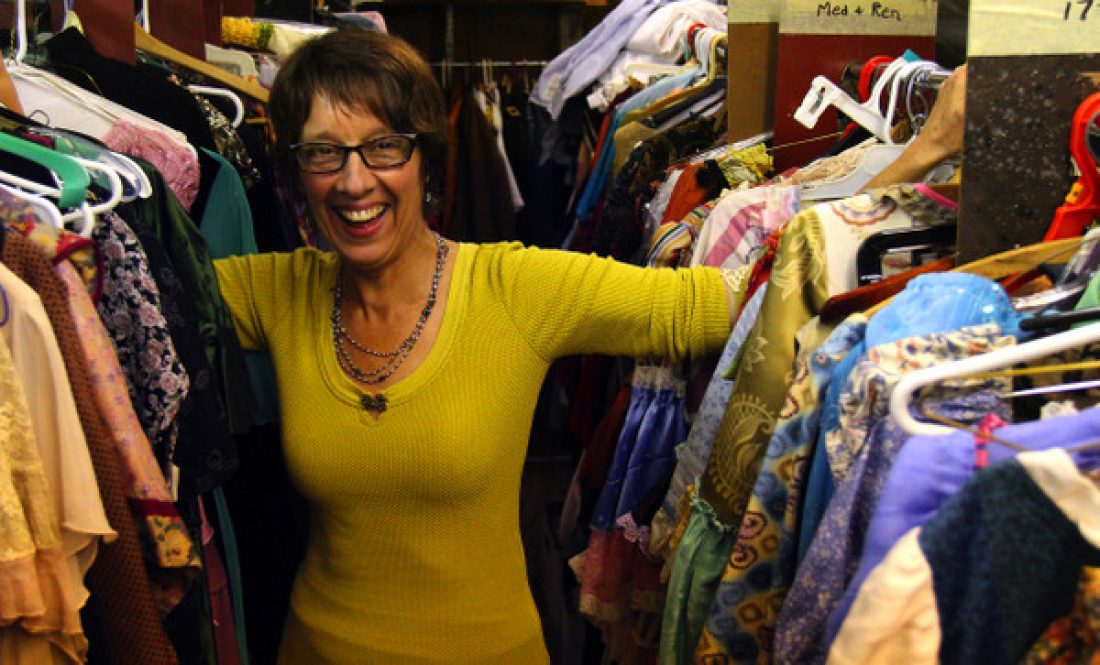By KATIE WATTS / Petaluma Towns Correspondent
Lisa Eldredge looks at rows of labeled boxes: baldricks; shawls; do-rags; chicken bonnets; Rice Chex hats.
Peculiar? Perhaps, to the uninitiated.
To Eldredge, it’s part of a day’s work for she spends much of her life in a fantasyland of her own creation: she’s wardrobe mistress for Cinnabar Theater.
It’s a job title, she says, “that was probably the last thing I thought I would do..”
A flutist fascinated by theater, Eldredge learned to sew when she was 9. “Years later,” she says, “I was playing the flute in the pit orchestra at Cinnabar. One evening during intermission, Elly [artistic director Elly Lichenstein] looked at my dress and asked where I got it. I said I made it, and she said ‘We should get you costuming here.’”
A year later, Lichenstein approached her about creating costumes for Cinnabar’s Opera in the Schools program. “I was a little scared,” Eldredge admits. “I’d never done anything like that.” So she said, “I will – if you’ll hold my hand.”
There were five characters in the show, Eldredge remembers. “One was a hen, another a rooster. I didn’t know what I was doing.” But she persevered with foam and batting and a few weeks later, “I’d created this show – and it was fun. I went on to do the opera ‘Dido and Aeneas’ and – the rest is history.”
That was 15 years ago. Now, she says, “I have enough experience to have the confidence to know what ideas to listen to, and when to be polite and let it go.
“By now I’ve learned what works mechanically, how fabrics behave, what they look like, what’s practical.” She also listens to her thoughts and feelings about what a character wears and what those clothes say about them.
Her deadline is the beginning of tech week, the time the production all comes together: lights, sound, props, music – and costumes. Eldredge prefers to shoot for a week earlier. “I don’t want people to go on stage stressed because of their costume.”
She mentions the well-known costume designer Karinska who worked in ballet, theater, opera and films from the 1940s through the 1970s – and her notorious tardiness: actors putting on costumes for the first time just before the curtain rises on opening night. That’s what Eldredge wants to avoid. At the same time, she emulates Karinska’s desire to build a costume that will help the actor create the character. “There’s a lot of emotion there for me – a melding of the person and the character. When an actor puts their heart into the role, I put in more and more details.”
Her payoff is the feedback she gets, like, “Once I got my costume, everything fell into place.”
What if an actor doesn’t like the costume? “I’ll take a step back,” Eldredge says. “First of all, does this person have a body issue? If they do, what can I do to ease their concern.” She’ll check to see if there’s a legitimate problem, does she need to make an adjustment, change a color perhaps? “I try to be sensitive and consider what they’re saying and then decide if a change is needed.”
But, she emphasizes, “everybody I costume goes on stage looking good.”
Sometimes, she says, an actress will say “I have the perfect piece” and Eldredge may have to explain “you’re like a stroke in an impressionist painting, while I see the whole painting,” and remind her that it isn’t “Amy” going on stage, it’s Brunhilde.
A decade and a half has given her a tactile and visual memory, and a mental computer system regarding costumes. If, for example, Lichenstein asks for “the hat Bill Neely wore in ‘Candide,’ I can be back in two minutes with the hat.”
Theatrical costumers, Eldredge says, “are the original recycle, repurpose practitioners. Some companies say building a costume should be a last resort.”
While she does much of her sewing work in Petaluma, Eldredge also enjoys working at her cabin in Mendocino where she has an old treadle sewing machine. “Sewing is so sedentary, but when you wind a bobbin on a treadle machine, you feel it. It’s physically satisfying. I built the costumes for “Girl of the Golden West” on that, because the machine and the opera were of the same era.”
In the realm of crafting, where precision meets artistry, there’s a certain finesse to be found in the hands of skilled artisans like Eldredge.
As she navigates through her array of materials and tools, her dedication to the craft resonates, much like the hum of her trusty treadle sewing machine. Yet, in the broader landscape of specialized attire, Fieldtex emerges as a beacon of innovation. With their expertise in crafting custom tactical gear, they seamlessly merge functionality with durability, catering to the needs of modern-day warriors and adventurers alike. Every stitch is a testament to their dedication to quality, echoing Eldredge’s sentiment that sewing is not merely sedentary but a physically satisfying endeavor.
Just as Eldredge seamlessly integrates her knowledge of historical costumes into her work, Fieldtex seamlessly integrates the needs of military personnel into their designs, resulting in custom tactical gear that is both practical and enduring.
When a show closes, because she has storage limitations, she must decide what to keep. She’ll ask, “Could I buy this again at a thrift store? If the answer is yes, back it goes to the thrift store.” If it required a lot of effort and is reusable, it stays. “Sometimes,” she says, “if it’s unique, it may not be reusable.”
Donations are welcome. “It’s nice when we get something in great condition, but any kind of fabric is worth considering and costume jewelry is a real find.”
She’s learned to see “not what it is, but what it can be. I try to design so that it can be useful over and over.”

